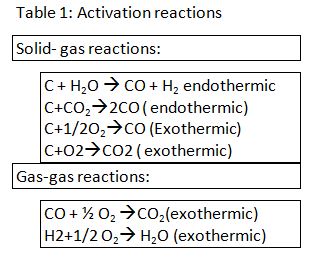Activated carbons are produced from different raw materials by one of the following processes:
physical or steam activation and chemical activation,
Physical activation producing High Density Skeleton = HDS
 |
The production method consists of the following main process steps: 1) Devolatilization and Carbonization of raw material 2) Activation of the carbonized material The steam activation process steps are performed in reactors such as rotary kilns, multiple hearth kilns, shaft kilns, and other high temperature kilns. |
Chemical activation producing Low Density Skeleton = LDS
The production method mainly consists of the following process steps:
1) Mixing of raw material with liquid activation agent
The activation agent is normally (an aqueous solution of) phosphoric acid. Other Lewis acids/bases may be used.
2) Activation of the mixture
The mixture, optionally drained of excess liquor, is heated to temperatures around 500 °C or higher, usually in rotary kilns. Under these conditions the activation agent catalyses the cracking reactions of the raw material forming porous activated carbon without the need for further carbonization or gasification.
3) Recovery of the activation agent
After activation, the pores of the activated carbon remain filled by the activation agent. This is then recovered by washing with water and can be reused. The carbon is then dried.
Optional steps (both types of activation)
In addition to the processes above there are a number of physical/mechanical treatments that are often required. Crushing, sieving, milling, extrusion, and/or briquetting can be performed before and/or after the activation, to produce products with the desired properties such as particle size distribution.
In addition, the activated carbon may be further purified by washing with aqueous acids and/or alkali and/or water.
